Q1. Describe the gynoecium of ground nut.
Solution
In ground nut, the ovary is superior, monocarpellary and unilocular with many ovules. The gynoecium has a single style.
Q2. Name the region of
the root whose epidermal cells form root hair.
Solution
The epidermal cells
of the region of maturation form root hair.
Q3. Distinguish
between zygomorphic flower and actinomorphic flower.
Solution
Zygomorphic
Flower
Actinomorphic
Flower
1. The flower can be divided into two
similar halves in one particular plane.
1. The flower can be divided into two equal
radial halves in any radial plane passing through the central axis of the
flower.
2. Examples: Mustard, Datura
2. Examples: Gulmohar, Pea
Q4. Explain
how the stem is involved in reproduction in jasmine and Chrysanthemum.
Solution
Jasmine:
A slender lateral branch arises from the base of the main axis. After growing
aerially for some time, it arches down to touch the ground.
Chrysanthemum: The lateral branches originate from the
basal and underground portion of the main stem. It grows horizontally beneath
the soil and comes out obliquely upwards to give rise to leafy shoots.
Q5. Describe the
different regions of the root.
Solution
The different regions of the root are as follows:
1. Root cap:
It covers the apex of roots which grow through the soil.
2. Region of Meristematic Activity:
This region is a few millimetres above the root cap.
The cells are thin-walled and small with dense
protoplasm. The cells divide repeatedly.
3. Region of Elongation:
This region is proximal to the region of meristematic
activity.
The cells in this region undergo rapid elongation
and enlargement.
This zone is responsible for the growth in length of
the root.
These cells gradually differentiate and mature.
4. Zone of Maturation:
The zone of maturation is proximal to the zone of
elongation.
Its epidermal cells
give rise to root hair cells which absorb water from the soil.
Q6. Write the
vegetative characters of the family Fabaceae.
Solution
The
vegetative characters of the family Fabaceae are as follows:
1. The
stem is erect or a climber.
2. Leaves
are alternate, pinnately compound or simple. The leaf base is pulvinate, stipulate and leaf venation is reticulate.
Q7. Describe the arrangement of calyx and corolla of sun hemp.
Solution
Calyx of sun hemp:
1. There are five sepals. It is gamosepalous and shows imbricate aestivation.
Corolla of sun hemp:
1. There are five petals. It is polypetalous consisting of posterior standard, two lateral wings and two anterior petals forming a keel. It exhibits vexillary aestivation.
Q8. State the type of
root in sweet potato which stores food.
Solution
Adventitious roots
in sweet potato are swollen to store food.
Q9. State the
function of stem tendrils.
Solution
Stem
tendrils help plants to climb.
Q10. Cite examples
of non-endospermous seeds.
Solution
Examples
of non-endospermous seeds are as follows:
Bean,
gram, pea
Q11. Explain the three types of phyllotaxy and give examples of each type.
Solution
The three types of phyllotaxy are as follows:
1. Alternate type of phyllotaxy:
A single leaf arises at each node in an alternate manner.
Examples: China rose, Sun flower
2. Opposite type of phyllotaxy:
A pair of leaves arise at each node and lie opposite to each other.
Examples: Calotropis, Guava
3. Whorled type of phyllotaxy:
More than two leaves arise at a node and form a whorl.
Example: Alstonia
Q12. State the
three parts of the carpel.
Solution
The three
parts of the carpel are ovary, style and stigma.
Q13. Name the root
system found in mustard plant.
Solution
The tap root system
is found in mustard plant.
Q14. What is the root
cap? State its function.
Solution
The root cap is the
structure which is thimble-like and covers the root apex. It protects the
tender apex of the root while it makes its way through the soil.
Q15. Name the
fruit which has a fibrous mesocarp.
Solution
Coconut
has a fibrous mesocarp.
Q16. Define
the following and give one example of each:
(a)
Bisexual flower
(b)
Unisexual flower
Solution
(a)
Bisexual flower: It is a flower in which both androecium and gynoecium are
present.
Example:
Tulip
(b)
Unisexual flower: It is a flower with only androecium or gynoecium.
Example:
Flower of papaya plant
Q17. Differentiate
between marginal and axial placentation.
Solution
Marginal
Placentation
Axial
Placentation
1. The placenta is in the form of
a ridge along the ventral suture of the ovary, and ovules develop on this
ridge.
1. The placenta is axial, i.e. develops on
the axis, and ovules are attached to the placenta in a multilocular form.
2. Example: Pea
2. Example: Tomato
Q18. Draw a
diagram of mango indicating the arrangement of its pericarp. Describe its
pericarp in short.
Solution
In mango,
the pericarp is well differentiated into an outer thin epicarp, a middle
fleshy edible mesocarp and an inner endocarp which is stony and hard.
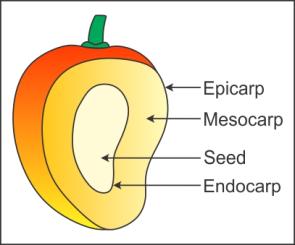

Q19. What is
the significance of brightly coloured petals?
Solution
Brightly
coloured petals attract insects for pollination.
Q20. What are
nodes and internodes?
Solution
Nodes are
the regions on the stem from which leaves develop, while internodes are the regions
between two nodes.
Q21. What is
aestivation? Distinguish between valvate aestivation and twisted aestivation.
Solution
Aestivation
is the mode of arrangement of sepals or petals in a floral bud with respect
to the other members of the same whorl.
Valvate
Aestivation
Twisted
Aestivation
1. Sepal or petals in a whorl
just touch one another. They do not overlap.
1. One margin of the floral
appendage overlaps the margin of the next appendage.
2. Example: Calotropis
2. Example: China rose
Q22. Name two plants
whose tap roots are modified to store food.
Solution
Carrot
Turnip
Q23. Define
venation.
Solution
The
arrangement of veins and veinlets in the lamina of the leaf is called
venation.
Q24. What are
thorns? Give one example of a plant in which thorns are found.
Solution
Thorns
are the modified axillary buds of the stem. Thorns are found in citrus
plants.
Q25. Draw a floral diagram for Solanum nigrum.
Solution
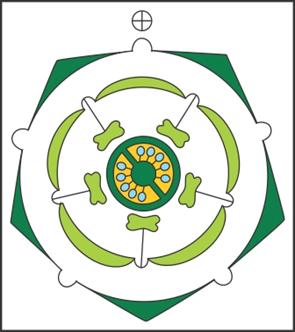
Q26. Draw a well-labelled diagram of the regions of the root tip.
Solution
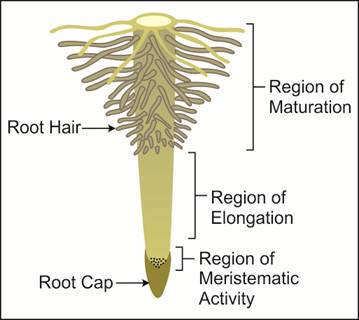
Q27. Name the
meristem from which leaves originate.
Solution
Leaves
originate from the shoot apical meristem.
Q28. State the function
of root hair.
Solution
Root hair absorbs
water and minerals from the soil.
Q29. What does a dot represent in a
floral diagram?
Solution
A dot in the floral diagram
represents the position of the flower axis with respect to the flower.
Q30. Name the two plants
which have stilt roots developing from the nodes of their stems.
Solution
Maize
Sugar Cane
Q31. State the
functions of the stem.
Solution
Functions
of the stem:
1. To
spread out the branches bearing leaves, flowers and fruits.
2. To
conduct water, minerals and photosynthates to different parts of the plant.
3.
Modified stems perform different functions such as storage of food,
protection, support, reproduction and photosynthesis.
Q32. How is
fusion indicated in a floral formula?
Solution
Fusion in
a floral formula is indicated by enclosing the figure in brackets.
Q33. Describe
epipetalous stamens.
Solution
When the
stamens are attached to the petals, they are called epipetalous stamens.
Q34. Explain
the following terms:
(a)
Gamosepalous calyx
(b)
Pentamerous flower
Solution
(a) A
gamosepalous calyx is one in which all the sepals are united.
(b) A
pentamerous flower is one in which the floral appendages are in multiples of
five.
Q35. What is modification of roots? Write the modification of roots found in the following plants:
(a) Maize
(b) Carrot
(c) Banyan tree
(d) Rhizophora
Solution
The roots in some plants are modified for support, storage of food and respiration.
(a) Maize: Stilt roots arise from the nodes of the stem to support the plant.
(b) Carrot: Roots are swollen and store food.
(c) Banyan Tree: Prop roots arise to support the tree.
(d) Rhizophora: Roots arise above the ground to obtain oxygen for respiration.
Q36. Describe
the structure of a dicotyledonous seed.
Solution
A
dicotyledonous seed is covered by a seed coat.
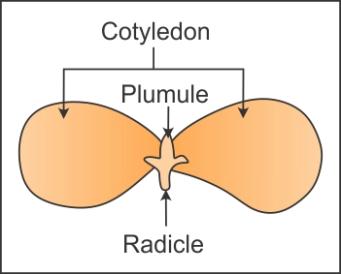 A seed
coat is made of two layers—an outer testa and an inner tegmen.
There is
a scar on the seed coat called hilum. Through the hilum, the developing seeds
are attached to the fruit.
A
micropyle is the small pore present just above the hilum.
An embryo
is enclosed by the seed coat.
The
embryo has an embryonal axis and two cotyledons.
The
cotyledons are fleshy, and they serve as the food reserves for the developing
embryo.
At the
two ends of the embryonal axis are the radicle and the plumule.
A seed
coat is made of two layers—an outer testa and an inner tegmen.
There is
a scar on the seed coat called hilum. Through the hilum, the developing seeds
are attached to the fruit.
A
micropyle is the small pore present just above the hilum.
An embryo
is enclosed by the seed coat.
The
embryo has an embryonal axis and two cotyledons.
The
cotyledons are fleshy, and they serve as the food reserves for the developing
embryo.
At the
two ends of the embryonal axis are the radicle and the plumule.
 A seed
coat is made of two layers—an outer testa and an inner tegmen.
There is
a scar on the seed coat called hilum. Through the hilum, the developing seeds
are attached to the fruit.
A
micropyle is the small pore present just above the hilum.
An embryo
is enclosed by the seed coat.
The
embryo has an embryonal axis and two cotyledons.
The
cotyledons are fleshy, and they serve as the food reserves for the developing
embryo.
At the
two ends of the embryonal axis are the radicle and the plumule.
A seed
coat is made of two layers—an outer testa and an inner tegmen.
There is
a scar on the seed coat called hilum. Through the hilum, the developing seeds
are attached to the fruit.
A
micropyle is the small pore present just above the hilum.
An embryo
is enclosed by the seed coat.
The
embryo has an embryonal axis and two cotyledons.
The
cotyledons are fleshy, and they serve as the food reserves for the developing
embryo.
At the
two ends of the embryonal axis are the radicle and the plumule.
Q37. Explain
the arrangement of flowers in racemose inflorescence.
Solution
In
racemose inflorescence, the flowers grow laterally on the main axis in an
acropetal succession.
Q38. Describe the structure of a monocotyledonous seed.
Solution
The seed coat which covers the seed is membranous and fused with the cell wall.
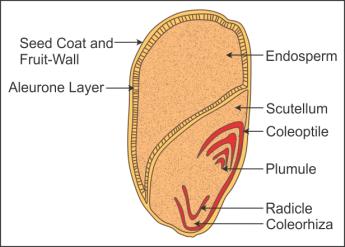 The endosperm is bulky, and it serves as the food reserve.
The outer covering of the endosperm is a proteinous layer called the aleurone layer.
A small embryo is located in a groove at one end of the endosperm.
A large shield-shaped cotyledon called the scutellum is present.
The embryo has a short axis with the radicle and plumule.
The radicle and plumule are enclosed in sheaths called coleorhiza and coleoptile, respectively.
The endosperm is bulky, and it serves as the food reserve.
The outer covering of the endosperm is a proteinous layer called the aleurone layer.
A small embryo is located in a groove at one end of the endosperm.
A large shield-shaped cotyledon called the scutellum is present.
The embryo has a short axis with the radicle and plumule.
The radicle and plumule are enclosed in sheaths called coleorhiza and coleoptile, respectively.
 The endosperm is bulky, and it serves as the food reserve.
The outer covering of the endosperm is a proteinous layer called the aleurone layer.
A small embryo is located in a groove at one end of the endosperm.
A large shield-shaped cotyledon called the scutellum is present.
The embryo has a short axis with the radicle and plumule.
The radicle and plumule are enclosed in sheaths called coleorhiza and coleoptile, respectively.
The endosperm is bulky, and it serves as the food reserve.
The outer covering of the endosperm is a proteinous layer called the aleurone layer.
A small embryo is located in a groove at one end of the endosperm.
A large shield-shaped cotyledon called the scutellum is present.
The embryo has a short axis with the radicle and plumule.
The radicle and plumule are enclosed in sheaths called coleorhiza and coleoptile, respectively.
Q39. Name the types of roots which originate from the base of the stem.
Solution
Fibrous roots originate from the base of the stem.
Q40. Define stem.
Solution
The stem is the ascending part of
the axis which bears branches, leaves, flowers and fruits.
Comments
Post a Comment